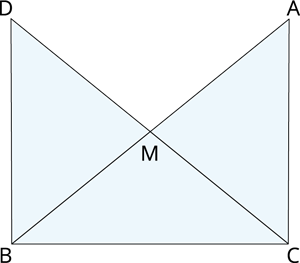In right triangle \(ABC\), right angled at \(C, M\) is the mid-point of hypotenuse \(AB\). \(C\) is joined to \(M\) and produced to a point \(D\) such that \(DM = CM\). Point \(D\) is joined to point \(B\).

Show that:
(i) \(∆ AMC ≅ ∆ BMD\)
(ii) \(∠DBC\) is a right angle.
(iii) \(∆ DBC ≅ ∆ ACB\)
(iv) \(CM = \frac{1}{2} AB\)
(i) Proof:
\(M\) is the mid-point of \(AB\)
So \(AM = BM\)
\(∠ ACB = 90^°\) and \(DM = CM\)
In \(ΔAMC\) and \(ΔBMD\), we have:
\(AM = BM\) [Given] ---- (1)
\(∠ CMA = ∠ \) [Vertically opposite angles] ---- (2)
\(CM = DM\) [Given] ---- (3)
Thus, by congruence rule \(ΔAMC ≅ ΔBMD\)
Hence, we proved.
(ii) Proof:
From above congruency we can say \(∠ ACD = ∠ BDC\)
Also alternate interior angles of two parallel lines \(AC\) and \(DB\).
Since sum of two co-interiors angles results to \(180^°\).
So, \(∠ ACB + ∠\) \(= 180^°\)
\(∠ DBC = 180^° – ∠ ACB\)
\(∠ DBC = 90^°\) { As \(∠ACB =90^°\)}
Thus, \(∠DBC\) is a right angle.
Hence, we proved.
(iii) Proof:
In \(ΔDBC\) and \(ΔACB\),
\(BC=BC\) [Common] ----- (1)
\(∠ ACB = ∠ DBC\) [Right angles] ----- (2)
\(DB = AC\) [by CPCT] ------- (3)
Thus, by congruence rule, \(ΔDBC ≅ ΔACB\)
Hence, we proved.
(iv) Proof:
As \(M\) is the mid point so we can say \(DM = CM = AM = BM\).
Also we can say that \(AB = CD\) [By CPCT]
As \(M\) is the mid point of \(CD\) we can write \(CM + DM = \)
Hence, \(CM + CM = AB\) [As \(DM = CM\)]
Thus, \(CM = \frac{1}{2} AB\)
Hence, we proved.